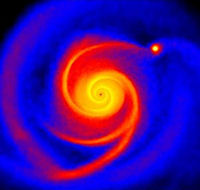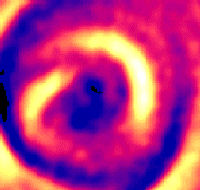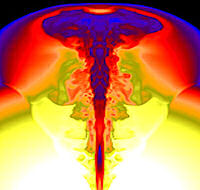|
TABLE: A short summary of the basic properties of accretion discs based on a lecture by Kristen Menou (November 2008, Nordita, Stockholm, Sweden)
|
|
Type
|
In proto-planetary systems |
Around white dwarfs
(WD) in cataclysmic binaries
|
In black hole (BH)
or neutron star (NS) binaries |
In quasars
and other AGN |
In gamma ray burst
(GRB) sources |
| Accretor |
|
|
|
|
|
Images
click the image |
 |
 |
 |
 |
 |
| Basic physics |
|
The central part of a dense molecular cloud collapses
to a proto-star surrounded by a proto-planetary accretion disc. Self
gravity and sedimentation trigger the formation of planets. Bipolar
outflows ("slow" jets) often emerge from proto-planetary discs.
|
|
|
U Gem is the prototype of a dwarf novae system, i.e. a
close stellar binary, with "primary" being a WD with accretion disc.
The disc's brightness in the visible light increases 100-fold every ~120
days and returns to the original level after a ~week, due to (mainly) a
limit-cycle instability.
|
|
|
X-ray binaries (XRB) consist a mass loosing
main-sequence "secondary" star and accreting BH or NS. Among XRBs, the
soft X-ray transients (with BH or NS) show quasi-periodic outbursts.
Most of the BH XRBs exhibit "fast" jets, and for this reason are called
microquasars.
|
|
|
AGN are supermassive BH at centers of galaxies.
Accretion produces radiative power that often outshines the host galaxy.
A large torus of gas and dust partially obscures the accretion disc.
"Fast" (almost speed of light) jets emerge from many AGNs.
|
|
|
GRBs are the most energetic explosions in the universe. Models of GRBs invoke a black hole (M~3Msun)
accreting matter at highly super-Eddington rates. The huge power of
gamma-rays is possibly due to an extraction of the BH rotational energy
(the Blandford- Znajek mechanism).
|
|
| Angular momentum transport |
|
Radial: in
the inner disc region and at the surface, where the disc is sufficiently
ionised (by X-rays, cosmic rays and collisions), via MRI induced
turbulence; in the dead zone via gravitational instability
Vertical: via outflows and/or torque exerted by large scale magnetic fields.
|
|
|
Local: in the high state via MRI induced turbulent viscosity;
Global: direct dissipation by tidal spirals when the incoming supersonic flow shocks on the accretion disc
|
|
|
Local: MRI drives a turbulent viscosity which also produces shear stresses;
Global: spiral shocks?
|
|
|
Inner disc: viscous friction (MRI);
Outer disc: unclear, possibly by global disturbances in the gravitational field (gravito-turbulence)
|
|
|
Inner disc: MRI induced turbulent viscosity (in the optically thick mid-plane a very large neutrino viscosity could shut off MRI);
Outer disc: (> 140 RG) uncertain
|
|
| Cooling |
|
Black body radiation, convection, collisions
|
|
|
|
Thin/slim disc: advection, black body radiation;
Adaf: advection, bremsstrahlung, Compton scattering
|
|
|
Thick disc (corona): bremsstrahlung, Compton scattering;
Thin disc: black body radiation
|
|
|
Inner disc: neutrino cooled;
Outer disc: advection cooled
|
|
Size
Rin-Rout
|
1011 - 1015 cm
10-2 - 200 AU |
109 - 1010 cm
10-4 - 10-3 AU |
106 - 1011 cm
10-7 - 10-2 AU |
106 - 1011 cm x [M/Msun]
10 - 106 RG |
105 - 10? cm x [M/Msun]
6 - 10? RG |
midplane
Temperature
|
103 - 101 K |
105 - 103 K |
107 - 103 K |
105 - 102 K |
1010 - 109 K |
Luminosity
|
L << LEdd |
L << LEdd |
L << LEdd
L ~ LEdd |
L < LEdd
L > LEdd, L >> LEdd |
L >> LEdd |
| Theoretical models |
|
Mostly thin discs, thick discs (early epochs), layered discs (with a magnetically inactive 'dead zone' in the mid-plane region)
|
|
|
Thin discs (truncated and with funnel/column accretion if the WD is magnetised)
|
|
|
Thin discs, slim discs, adafs
|
|
|
Thick discs (corona), slim discs
|
|
|
Thick discs, thin discs, hyper-accretion, ndaf
|
|
| References |
Hartmann (1998)
Alexander (2008) |
Frank, King & Raine (2002)
Warner (2003) |
Frank, King & Raine (2002)
Remillard & McClintock (2006) |
Krolik (1998)
on-line compilation |
Popham, Woosley & Fryer (1999)
Di Matteo, Perna & Narayan (2002) |
| |




